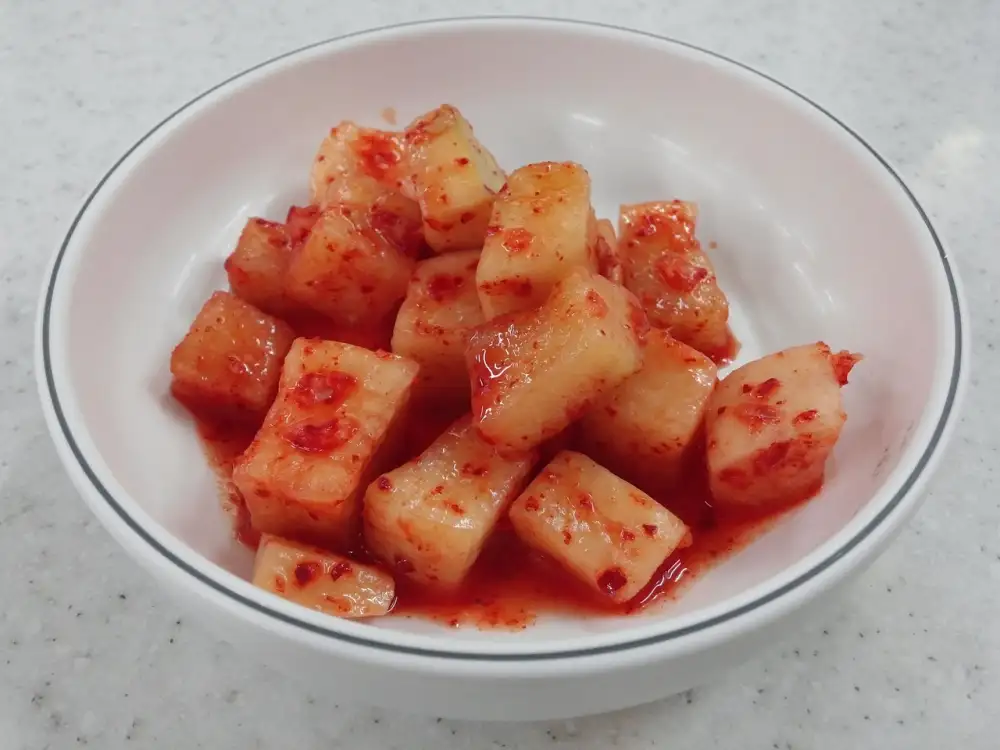Effortless Kimchi Recipe: A Quick and Easy Guide to Making Delicious Kimchi at Home

- List of ingredients required for making kimchi.
- Step-by-step instructions on how to prepare kimchi at home.
- Tips for adjusting the spice level and fermentation time to suit personal preferences.
- Serving suggestions and ways to incorporate kimchi into various dishes.
- Health benefits of consuming kimchi and its probiotic properties.
Kimchi, a staple in Korean cuisine, is a traditional fermented dish made from vegetables, most commonly napa cabbage and radishes, seasoned with a mix of spices like chili powder, garlic, ginger, and fish sauce. Known for its bold flavors and health benefits, kimchi has gained popularity worldwide for its unique taste and probiotic properties. It is often enjoyed as a side dish or incorporated into various recipes to add a punch of flavor. The art of making kimchi has been passed down through generations in Korean culture, symbolizing the country's rich culinary heritage.
List of ingredients required for making kimchi.
To make delicious kimchi at home, you will need the following ingredients:
1. Napa cabbage - 1 large head
2. Korean radish - 1 medium-sized
3. Coarse sea salt
4. Korean red chili flakes (gochugaru)
5. Fish sauce
6. Garlic cloves
7. Ginger
8. Green onions
9. Carrots
10. Sugar
These ingredients come together to create the signature spicy, tangy, and umami flavors that define traditional kimchi recipes. Adjusting the quantities of chili flakes and garlic can personalize the level of heat and pungency in your kimchi recipe.
Step-by-step instructions on how to prepare kimchi at home.
Step-by-step instructions on how to prepare kimchi at home:
1. Start by washing and cutting 1 Napa cabbage into bite-sized pieces. Place the cabbage in a large bowl and sprinkle with ¼ cup of salt. Mix well and let it sit for about 2 hours.
2. Rinse the cabbage thoroughly to remove excess salt, then drain and set aside. In a separate bowl, mix ½ cup of Korean red pepper flakes (gochugaru), 1 tablespoon of minced garlic, 1 teaspoon of minced ginger, 2 tablespoons of fish sauce, and 1 tablespoon of sugar.
3. Add sliced radish, carrots, green onions, and any other desired vegetables to the spice mixture. Toss in the cabbage until everything is evenly coated.
4. Pack the kimchi tightly into a clean glass jar, pressing down to remove air bubbles. Leave some space at the top as the kimchi will expand during fermentation.
5. Seal the jar tightly and let it ferment at room temperature for 1-2 days before transferring it to the refrigerator. The longer it ferments, the tangier it will become.
6. Remember to burp the jar daily by slightly opening it to release built-up gases from fermentation. Enjoy your homemade kimchi as a delicious side dish or ingredient in various recipes!
Tips for adjusting the spice level and fermentation time to suit personal preferences.
To adjust the spice level of your kimchi, you can increase or decrease the amount of gochugaru (Korean red pepper flakes) used in the recipe. For a milder flavor, reduce the gochugaru, and for a spicier kick, add more. Additionally, adjusting the fermentation time can impact the tanginess and overall flavor profile of your kimchi. A shorter fermentation period will result in a fresher taste, while a longer one will develop a stronger, more pungent flavor. Experiment with different durations to find your preferred balance of flavors.
Serving suggestions and ways to incorporate kimchi into various dishes.
Kimchi is a versatile ingredient that can enhance the flavor of various dishes. It can be enjoyed on its own as a side dish, added to rice bowls, mixed into soups or stews for extra depth of flavor, or even used in sandwiches and wraps for a spicy kick. Kimchi fried rice is a popular dish where kimchi is stir-fried with rice and other ingredients like vegetables and proteins. Kimchi pancakes are another delicious option where kimchi is mixed into a batter and pan-fried until crispy. The tangy and spicy flavors of kimchi can complement both traditional Korean dishes and fusion cuisine, making it a valuable addition to any meal.
Health benefits of consuming kimchi and its probiotic properties.
Kimchi is not only a flavorful dish but also offers numerous health benefits. As a fermented food, kimchi is rich in probiotics that promote gut health by introducing beneficial bacteria to the digestive system. These probiotics can help improve digestion, boost the immune system, and reduce inflammation in the body. Additionally, kimchi is packed with vitamins A, B, and C, as well as antioxidants that support overall well-being and may even aid in weight management. Incorporating kimchi into your diet can be a delicious way to enhance your health from the inside out.
In conclusion, making homemade kimchi is a rewarding and enjoyable experience that offers a delightful way to explore Korean cuisine. Despite its traditional roots, preparing kimchi at home can be easy and fuss-free, allowing you to customize the flavors to suit your taste preferences. The satisfaction of creating a batch of delicious kimchi from scratch is truly unmatched, providing not only a tasty condiment but also a sense of accomplishment in mastering this beloved dish. So why not embark on your kimchi-making journey today and savor the joy it brings to your culinary adventures!
Published: 16. 03. 2024
Category: Recipes



